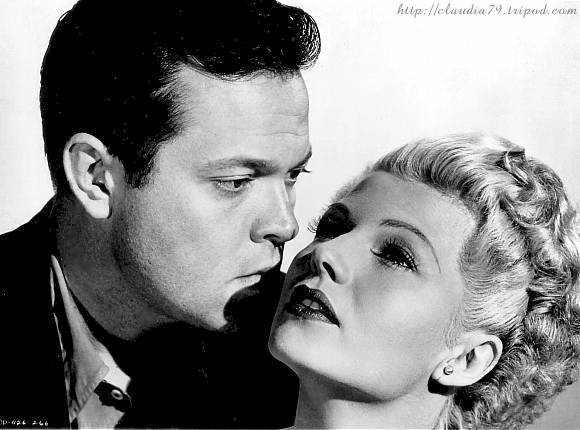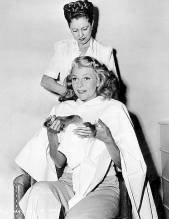

Produced, Directed and Written by Orson Welles
Welles' screenplay based on novel,
"If I Should Die Before I Wake," by Sherwood King
|
Rita Hayworth as Elsa Bannister Orson Welles as Michael O'Hara Everett Sloane as Arthur Bannister Glenn Anders as George Grisby Ted de Corsia as Sidney Broome Erskine Sanford as Judge |
Song vocals for Miss Hayworth: Anita Ellis
Costumes by Jean Louis
Black and White, 87 mins. running time
| There are several conflicting stories as to how the idea for The Lady from Shanghai came about. In New York, Orson Welles was running low on funds for his stage production of Around the World in 80 Days. One story has Welles putting in a call to Columbia studio head Harry Cohn asking for $50,000, and in return, Welles would direct a picture for Columbia. Then when asked if he had a story in mind, Welles glanced over and saw the book "The Lady from Shanghai". There variations to this tale, therefore the entire truth is unclear, but what's important is the end result, which is that Welles produced, directed, wrote and starred in The Lady from Shanghai. And it is loosely based on the novel by Sherwood King, If I Should Die Before I Wake. |
 One of the things significant about this film was that it marked the end of Rita's marriage to Orson. They had been separated long before filming began, but they were on good terms during filming, calling each other "mama" and "papa". But it appeared there would be no reconciliation. Rita said, "When I made The Lady from Shanghai we were separated but were still friends." However, many say Rita was still in love with her estranged husband. Alas, just weeks after filming, she filed for divorce. Afterwards, Rita never spoke ill of him in the press. She told Louella Parson's column, "I think if you loved a man enough to marry him, the least you can do, if you must part, is to say nothing against him."
One of the things significant about this film was that it marked the end of Rita's marriage to Orson. They had been separated long before filming began, but they were on good terms during filming, calling each other "mama" and "papa". But it appeared there would be no reconciliation. Rita said, "When I made The Lady from Shanghai we were separated but were still friends." However, many say Rita was still in love with her estranged husband. Alas, just weeks after filming, she filed for divorce. Afterwards, Rita never spoke ill of him in the press. She told Louella Parson's column, "I think if you loved a man enough to marry him, the least you can do, if you must part, is to say nothing against him."
|
 Additionally, for Hayworth fans, one of the most memorable things about The Lady from Shanghai is her hair. For this one and only time, Rita had her trademark long, flowing red hair cut short and dyed a shade known as "topaz blonde" (it was platinum blonde). Although I've read otherwise once or twice, the idea for the hairstyle change was Orson Welles. He even selected the dye. Stories about Harry Cohn being furious about it are unlikely, considering he was the boss and would have been informed. The haircutting was a highly publicized event known as "The Million Dollar Haircut". Over a dozen photographers were in attendance, snapping pictures of Rita with her hair stylist, Helen Hunt, and some with Orson supervising. Miss Hunt later said, "The pictures which show Rita holding her hair are made up. This hair belonged to a little seamstress in the wardrobe department." Perhaps this is true for some of the photos, but many show she actually was getting her hair cut, so why would it be necessary to get another person's hair for her to hold? The drastic cut and color change didn't go over as well as Orson and the studio hoped. Most fans were none too pleased about it, they wanted Rita's hair the way it was before! Rumor has it that the studio was besieged with letters requesting locks of the shorn tresses (which had been thrown away)!
Additionally, for Hayworth fans, one of the most memorable things about The Lady from Shanghai is her hair. For this one and only time, Rita had her trademark long, flowing red hair cut short and dyed a shade known as "topaz blonde" (it was platinum blonde). Although I've read otherwise once or twice, the idea for the hairstyle change was Orson Welles. He even selected the dye. Stories about Harry Cohn being furious about it are unlikely, considering he was the boss and would have been informed. The haircutting was a highly publicized event known as "The Million Dollar Haircut". Over a dozen photographers were in attendance, snapping pictures of Rita with her hair stylist, Helen Hunt, and some with Orson supervising. Miss Hunt later said, "The pictures which show Rita holding her hair are made up. This hair belonged to a little seamstress in the wardrobe department." Perhaps this is true for some of the photos, but many show she actually was getting her hair cut, so why would it be necessary to get another person's hair for her to hold? The drastic cut and color change didn't go over as well as Orson and the studio hoped. Most fans were none too pleased about it, they wanted Rita's hair the way it was before! Rumor has it that the studio was besieged with letters requesting locks of the shorn tresses (which had been thrown away)!This was the last film Rita made for Columbia under the terms of her old contract. She had formed her own production company, Beckworth, and after this film, Rita would receive a share of the profits her future films made, in lieu of a salary. Therefore, this would be Harry Cohn's last chance to collect all the profits off of Rita Hayworth's notoriety. Most of The Lady from Shanghai was shot on location in Acapulco, Mexico and in San Francisco’s Chinatown District. The yacht used in the film was actually screen legend Errol Flynn's yacht, The Zaca.
|
|
The scene opens in New York City where sailor Michael O'Hara (Orson Welles) meets Elsa Bannister (Rita Hayworth) during a stroll through Central Park. He comes to her rescue when she is held up by thieves. Now something of a hero to Elsa, she takes a liking to him and offers him a job aboard her yacht, which is soon to set sail for San Francisco. Michael declines when he finds out she's married. Her husband is Arthur Bannister (Everett Sloane), "The World's Greatest Criminal Lawyer". But Elsa is not one to take no for an answer. The next day she sends Arthur to coax Michael into working for them. He's finally persuaded by their maid, Bessie (Evelyn Ellis), who suggests that Elsa is in danger. Within a short time, Michael falls for Elsa, and learns that she was forced into marrying Arthur.
Along the journey to San Francisco, Arthur's business partner, George Grisby (Glenn Anders), joins them on the yacht, and they soon reach the beaches of the Mexican coast. There Grisby offers Michael $5,000 to sign a confession saying he killed Grisby. The scheme is to have Michael say he killed him, so that Grisby can vanish to an island in the South Seas without the world searching for him. Grisby tells Michael that the purpose of the deception is to escape his wife, and also because he fears the end of the world is upon them, and he wants to be off on a remote island when it comes. Michael agrees to take part in the cockeyed scheme after Grisby assures him that he cannot go to jail for murder unless the corpse is found. He's offered $5,000 for his services, which he plans to use to run away with Elsa. Once he receives his payment and has signed the murder confession, Michael finds himself in serious trouble. Grisby is found dead. Having arrived in San Francisco’s Chinatown district, Michael finds himself needing the services of "The World's Greatest Criminal Lawyer", Arthur Bannister. Unfortunately, Arthur knows all about Michael and Elsa's romance, and he is not anxious to get him acquitted. Knowing the jury will find him guilty, Michael swallows a handful of Arthur's painkillers and escapes the courthouse, determined to find the missing gun that killed Grisby, which can prove his innocence. He hides from the police in a Chinese Theater. Elsa quickly tracks him down. There Michael finds Elsa's gun in her purse and the mystery begins to unravel; Elsa killed Grisby. By now, Michael is feeling faint from the painkillers and he passes out. When Michael regains consciousness, he finds himself in a deserted funhouse where Elsa has hidden him from the cops. It is here that everything becomes clear to him -Elsa and Grisby planned to kill Arthur and collect the insurance money. Grisby was to kill Arthur, then take his share of the money and disappear, leaving everyone to think he is dead, that Michael killed him. But that was not what Elsa had in mind. Her plan was to kill Grisby once he had killed Arthur, collect the insurance money, and leave Michael to take the fall for Grisby's murder. But the plan was wrecked when Grisby killed detective Sidney Broom (Ted De Corsia), who had found out about their devious plot. That was not part of her plan. Elsa got scared that the police would get Grisby for murdering Broom before he killed Arthur, then he'd tell them everything. So Elsa found it necessary to kill Grisby as soon as possible. Arthur finds out about Elsa's schemes and leaves a note with the district attorney clearing Michael's name. This leads to a showdown in the hall of mirrors. Elsa and Arthur shoot it out and after the last shots are fired, both are left dying. Michael leaves the funhouse a free man with the famous last words, "Maybe I'll live so long, that I'll forget her. Maybe I'll die trying." |
|
The Lady from Shanghai finished filming in February of 1947 but apparently Harry Cohn, unhappy with the final product, was not anxious to release it. The film was shelved for over a year and finally debuted in April of 1948, a critical and box-office fiasco. Once The Lady from Shanghai was completed, Orson left directing Hollywood films until 1958, when his immortal classic, Touch of Evil was released. Nowadays The Lady from Shanghai is considered a classic. Even though it was met with harsh criticism in 1948, over the years Rita always maintained it was a favorite of hers. She had absolute trust in Welles' abilities as a filmmaker. She said, "See, Orson was trying something new with me, but Harry Cohn wanted 'THE IMAGE", The Image he was going to make me until I was ninety!"
|
